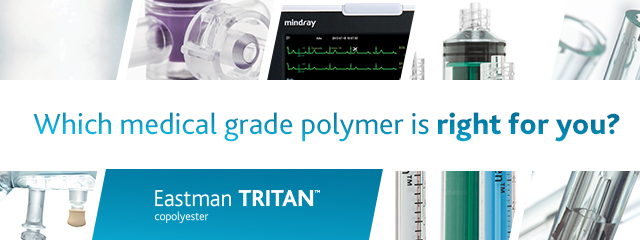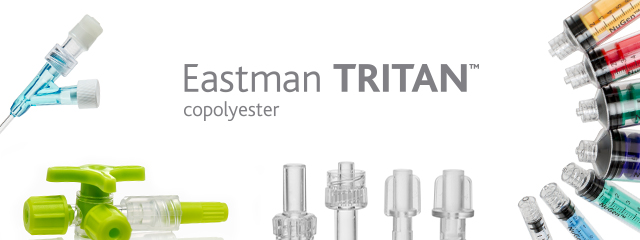Improving medical device cleanability and durability

NOTE: We appreciate you being part of our TritanMoldIt community! To ensure we are covering the information you need to best serve your customers and advance your business, we invite you to fill out this brief survey. As a thank you, you will have the option to be entered in a drawing for an Amazon Echo Show!
- Read more about Improving medical device cleanability and durability
- Log in or register to post comments
Join Eastman at MD&M West 2020

Eastman is excited to exhibit at Medical Design & Manufacturing (MD&M) West 2020! Join us February 11–13 in Anaheim, California, as we share exciting new innovations that are helping improve medical equipment and create positive health outcomes.
At MD&M West 2020, we’ll be highlighting the latest advancements in medical technology and the collaborations that are key to success in the medical market. Don’t miss out any of the fun:
- Stop by booth 2301 to learn about four new products as part of the Eastman Tritan™ MXF portfolio of medical polymers.
- Attend our Lunch and Learn events to discover what industry experts are saying about the future of medical devices and packaging.
- Register for one-on-one sessions with members of Eastman’s medical device and packaging teams.
- Read more about Join Eastman at MD&M West 2020
- Log in or register to post comments
An innovative solution to medical device housing failure

As healthcare facilities ramp up the use of aggressive disinfectants, traditional plastics are feeling the strain. It’s all too common to see device housings become sticky; wear thin in high-touch areas; or crack, crumble, or shatter after only a few months of service. The issue? Devices that were designed just a few years ago are typically made with materials that lack the right combination of impact strength and chemical compatibility with today’s stringent cleaning protocols.
Eastman Tritan™ copolyester is an excellent choice for medical housings due to its superior toughness and high chemical resistance. Using Tritan in your device can also help prevent costly repairs and replacements, keeping patients safe and customers happy.
- Read more about An innovative solution to medical device housing failure
- Log in or register to post comments
Supporting a circular economy

Traditionally, the world operates in a linear economy—raw materials are used to make products, which are then used and disposed of as waste. A circular economy focuses on making the most of the world’s resources by providing end-of-life solutions to reduce, reuse, and recycle products and materials that typically end up in landfills and waterways.
For manufacturers, there’s a lot to consider when making the shift to circular processes or materials. Eastman has developed a unique platform of solutions focused on minimizing waste and maximizing value to support the evolution of the circular economy. Our portfolio of circular solutions includes:
Advanced circular recycling (ACR)
For manufacturers, there’s a lot to consider when making the shift to circular processes or materials. Eastman has developed a unique platform of solutions focused on minimizing waste and maximizing value to support the evolution of the circular economy. Our portfolio of circular solutions includes:
Advanced circular recycling (ACR)
- Read more about Supporting a circular economy
- Log in or register to post comments
Check out the Tritan Mold It app!

With this handy app, users can:
- Calculate drying time
- Calculate melt residence time
- Calculate shot capacity utilization
- Download data sheets
- Watch videos
- Get advice from the Tritan experts
- Read more about Check out the Tritan Mold It app!
- Log in or register to post comments
Which medical grade polymer is right for you?

We know that material choice is a crucial component of any medical device or device housing. When you’re deciding what medical grade polymer you need for your next project, consider these criteria:
- Does it make the grade?
- Will it match the application?
- Read more about Which medical grade polymer is right for you?
- Log in or register to post comments
Navigating the complexities of compatibility with oncology drugs

The need to mitigate infection risks and enhance patients’ safety and comfort has significantly increased the demand for higher-performing plastics with improved chemical resistance. Many polymers commonly used in drug delivery devices simply do not hold up to modern oncology chemotherapies. After exposure to chemicals in the medical environment, devices made with these polymers can experience environmental stress cracking or premature failure in the presence of applied or residual stress.
Broken devices put patients at risk. What’s more, regulatory agencies may tell manufacturers to stop using certain materials when device performance or life cycle is compromised.
- Read more about Navigating the complexities of compatibility with oncology drugs
- Log in or register to post comments
Eastman Tritan™ copolyester—superior attributes for medical devices

Eastman Tritan™ copolyester is raising the bar for durability and cleanability in medical devices and housings. BPA-free Tritan’s attributes include exceptional clarity, toughness, improved heat and chemical resistance, and more. It’s also easy to process due to its unique chemical makeup relative to traditional thermoplastics. This blend of processing and performance properties provides greater advantages compared with other commonly used polymers. Available in clear and opaque formulations, Tritan offers many benefits to enhance innovative device designs:
Clear formulations of Tritan
- Greater toughness, heat resistance, processability, and design freedom
- Read more about Eastman Tritan™ copolyester—superior attributes for medical devices
- Log in or register to post comments
Educating product managers on how plastics affect your brand

The material you choose for your medical devices can have a big impact on your brand’s image. In today’s healthcare environment, not all plastics can withstand exposure to the aggressive disinfectants being used in hospitals. If your device is showing outward signs of suffering from exposure to effects of disinfection, including yellowing, cracking, crazing, or paint peeling, it’s time to reconsider material selection.
- Read more about Educating product managers on how plastics affect your brand
- Log in or register to post comments
Keys to classifying failures for quality engineers

Medical device failures are a common—and costly—occurrence. They can lead to a product recall, affect the product development cycle, and result in extra expenses for manufacturers. The reasons devices fail can be complex, making it difficult for quality engineers to classify the problem.
What can quality engineers do to remedy this problem? Consider these factors:
- Understand why failures occur: Most device failures are caused by a misunderstanding of how a material’s properties, processing, and environment work together. In many cases, failures can result from a combination of wrong material selection, poor chemical resistance, high-stress design, or inconsistencies in manufacturing processes.
- Collaborate with your supplier: Working with material suppliers on material selection, testing, part and tooling design review, and secondary operations can give quality engineers access to knowledge and resources they may not otherwise have.
- Read more about Keys to classifying failures for quality engineers
- Log in or register to post comments





 Close
Close


